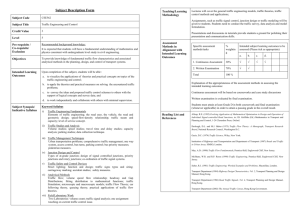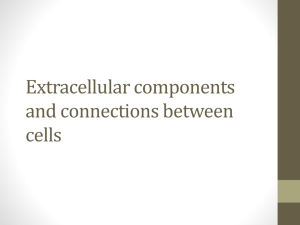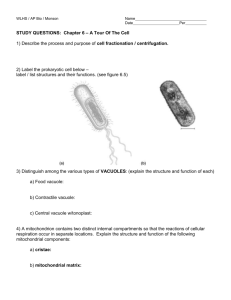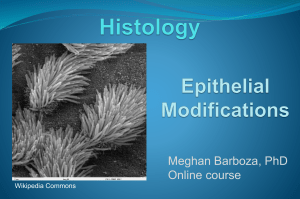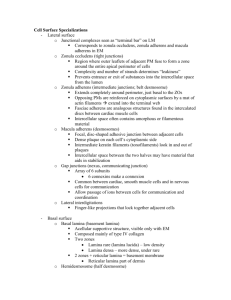Tight junction (zonula occludens)
advertisement
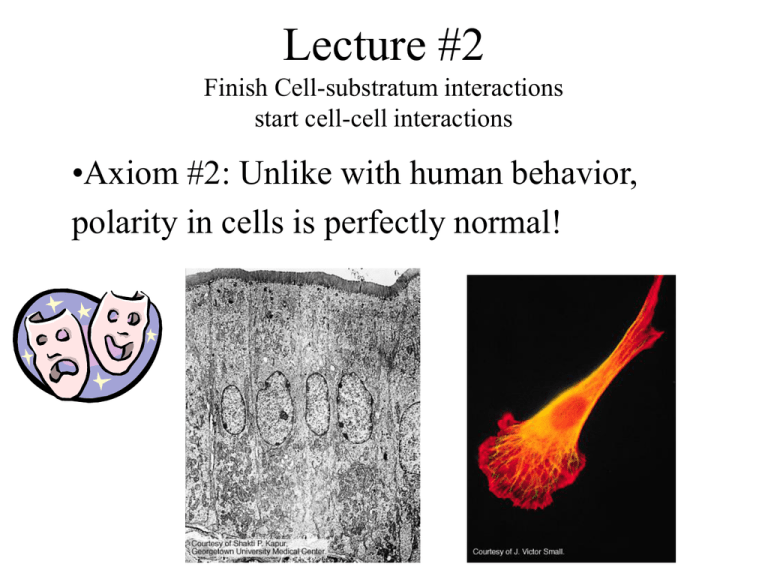
Lecture #2 Finish Cell-substratum interactions start cell-cell interactions •Axiom #2: Unlike with human behavior, polarity in cells is perfectly normal! Hemidesmosomes (HD) • a6b4 integrin is a major component of the HD, and can transduce signals from the ECM to the interior of the cell. • This signal modulates the cytoskeleton, differentiation, apoptosis, and proliferation. Hemidesmosomal proteins • BP 230 and Plectin: link to Ifs • a6b4 integrin: binds laminin in ECM and plectin in cytoplasm • BP180: links integrin to BP230, may bind laminin. • Absence or defects in hemidesmosome proteins results in severe blistering of the skin. Molecules that mediate cell-cell adhesion • • • • Cadherins Immunoglobulin members Integrins (lecture #1) Selectins SELECTINS Leukocytes Endothelial • The selectins are cell surface lectins that mediate adhesion of white blood cells to endothelial cells and platelets. • They recognize fucosylated, sialylated and in some cases sulfated ligands expressed on glycoproteins Platelets • Physiologically important in inflammation, immunological responses, and homing of bone marrow stem cells and lymphocytes. • Role in atherosclerosis, ischemiareperfusion injury, inflammatory diseases, and metastatic spreading of some cancers Recently, the selectin family of glycoprotein adhesion molecules (P-selectin, E-selectin, and L-selectin) has been implicated in the pathogenesis of a number of inflammatory disease states. The selectins modulate the early adhesive interactions between circulating neutrophils and the endothelium. See next slide . acute inflammation and Cell adhesion is important in metastasis. Pg. 277 1. Walls of small vein (venule) respond to signals from damaged tissue, causing activation of endothelial cells that are more adhesive to circulating neutrophils 2. Adhesion is mediated by transient display of P- and E-selectins on endothelial surface 3. Neutrophils bind to selectins, transendothelial migration is slowed to a “roll”. 4. Integrins on neutrophils become activated (role for platelet activating factor), tighter binding. Integrins bind with high affinity to ICAMS (IgSF) on endothelial cell surface 5. Bound neutrophil undergoes dynamic shape changes (THINK ABOUT CELL MOTILITY AND THE CYTOSKELTON) to pass through endothelial layer (extravasation) Fig. 7.22 Cell-adhesion molecule of the immunoglobulin (Ig) superfamily • Most Igs involved in immune function Interaction of two L-1 molecules • Some mediate Ca2+-independent cell-cell adhesion with 6 immunoglobulin domains Examples • NCAM: Neural Cell Adhesion Molecule • L1: also common in neurons • VCAM: Vascular cell adhesion molecule • Nectin: found at AJs. • VCAM binds integrin, which links cells to cells and to ECM Fig 7.23 Cadherins: Mediate Ca2+-dependent cell adhesion 1. 5 extracellular domain repeats 2. Terminal domains form an interdigitating zipper with cadherins on neighboring cells Cadherins mediate signal transduction from ECM to cytoplasm Cell-cell junctional complexes Components of a junctional complex: Tight junction (zonula occludens) Adherens junction (zonula adherens): Desmosome (macula adherens) Gap Junctions/Nexus Junctions: (GJIC) Junctional complexes between cells Fig. 7.25 Tight junction Adherens junction Desmosome Hemidesmosome Gap junctions TJ Vensus Says: “Why should you care about junctional complexes?” • LAD: Leukocyte adhesion deficiency: Afflicted individuals are unable to produce b2 subunit of integrin. Leukocytes are unable to adhere to endothelial layer of blood vessels. Bacterial infections can be life threatening • Blood-Brain Barrier: The principal anatomical component of the blood-brain barrier is the endothelial tight junction which opens in glioma microvessels. A common property of brain tumors is their ability to cause edema in the surrounding brain. Edema forms as a result of a leaky blood-tumor barrier and persists when the brain fails to clear the excess fluid. It is a significant source of morbidity and mortality • Cirrhosis: Tight junctions (TJ) of biliary epithelial cells and hepatocytes prevent bile regurgitation from the biliary tract. Alterations in these TJs result in chronic cholestatic liver diseases such as primary biliary cirrhosis (PBC) and primary sclerosing cholangitis (PSC). Tight Junctions separate apical from lateral plasma membrane • Continuous belt around circumference of cell • Anchorage for terminal web • adhesive contact between cells • Control of paracellular permeability. Transepithelial resistance. Fig. 7.30 TEM of tight junction Tight junction = zonulae occludens (ZO) The tight junction forms a regulated barrier to paracellular transport of solutes and ions. The barrier contains aqueous channels capable of discriminating charge and size. Cell 1 Cell 2 139037 apical Tight junctions Fig. 7.30 • The TJ strands visible in EM are composed mainly of the proteins claudins and occludin. • Claudins polymerize within the plasma membranes to assemble the backbone of the fibrils seen in freeze fracture. Claudins and Occludins Claudin family (1-20). Small integral membrane proteins 20-24 kDa. Might create the selective paracellular properties Claudins 1-8 bind ZO-1,-2 and -3. Occludin: an integral membrane protein that copolymerizes with the clauding polymers Tight Junction Proteins • ZO-1, ZO-2, and ZO-3: all three bind occludin • ZOs link TJs to actin-based cytoskeleton • Belong to MAGUK family – Membrane-associated guanlyate kinase proteins – All MAGUK protein characterized by: PDZ domains: post synaptic density-95, Dlg-A, ZO-1. SH3 domain: Src homology 3. Mediates protein interactions GK domain: homologous to enzyme that catalyzes GMP to GDP. MDCK cells stained for ZO-1 and claudin 4 • Figure 2. Immunofluorescent colocalization of ZO-1 and claudin-4 in tet-off claudin-4– transfected MDCK cells. • ZO-1 (a and c) and claudin-4 (b and d). ZO-1 is narrowly focused at the apical junction, while claudin-4 in both uninduced (b) and induced (d) MDCK cells is concentrated at cell-cell borders. Regulated expression of claudin-4 decreases paracellular conductance through a selective decrease in sodium permeability Christina Van Itallie 1 1, Christoph Rahner1 and James Melvin Anderson1,2 Department of Internal Medicine, and 2 Department of Cell Biology, Yale University School of Medicine, New Haven, Connecticut, USA J Clin Invest, May 2001, Volume 107, Number 10, 1319-1327 Copyright ©2001 by the American Society for Clinical Investigation Components of a junctional complex: Tight junction (zonula occludens) Adherens junction (zonula adherens) Desmosome (macula adherens) Gap Junctions/Nexus Junctions: (GJIC) Functional cross-talk between AJs and TJs. • ZO-1 is almost exclusively localized to tight junctions in kidney epithelial cells. • In cells that are less-well polarized or in stratified epithelial, ZO-1 is associated with adhesions junctions. Adherens junctions Major role in folding and bending of epithelial cell sheets . • Adhesive function • Two types 1) Belts: Encircle cells (Zonulae Adherens) 2) Spots: adhesion plaques • Ca2+-sensitive • Transmit EC signals to cytoskeleton Adherens junction Fig 7.26a Often referred to as cadherin-based AJs. •Transmit extracellular signals to cytoskeleton : cadherin linked to catenin which is linked to actin filaments Cadherins: role in metastasis? • Switch from E-cadherin to N-cadherin in metastatic melanocytes. Adherens Junctions: Zonulae Adherens b-Catenin binds: N, E-Cadherins Transcription factors (Lef/Tcffamily) Tumor supressor gene APC 2. The cadherin-catenin complex mediates Ca2+-dependent cell-cell adhesion. 3. g-Catenin binds cadherins and acatenin. Also mediates interaction between desomsomal cadherins and Intermediate filaments. 4. g Catenin: plakoglobin b-Catenin Controls Hair Follicle Morphogenesis and Stem Cell Differentiation in the Skin • • • • Keratin 14-Cre-Induced Deletion of the catenin Gene Abrogates Hair Follicle Morphogenesis and Maintenance of Hair (a–c) Fur of K14-Cre(neo); floxed -catenin mice at P8, P16, and P30, respectively. (d) Hematoxylin/eosin-stained transversal sections of mutant back skin at P8; the blue line marks the area lacking hair follicles. (e) Expression of -catenin in wild-type and (f) in mutant skin at E15. Immunofluorescence analysis (red) was performed using an antibody against an epitope of the C terminus of -catenin, DAPIstained nuclei are shown in blue, a white dotted line marks the basement membrane between epidermis and dermis. Bars: (d) 200 µm; (e and f, shown in [f]) 10 Cell, Vol 105, 533-545, May 2001 Joerg Huelsken1, Regina Vogel1, Bettina Erdmann1, George Cotsarelis2, and Walter Birchmeier1 B-catenin in involved in Wnt signalling pathway. • • Diagram of Possible Ways to Effect an Epithelial Mesenchymal Transition (EMT) Evidence has been collected from tissue culture experiments for each of the steps outlined. There are some good correlations between the expression of Snail and EMTs in vertebrate embryos. The possibility that Wnt signaling has a similar effect in vivo remains to be explored Take Home Messages • b –Catenin can be in the cytoplasm or the nucleus. – Cytoplasm: located in adherens junctions where it binds cadherins through the armadillo repeats and establishes a link to the cytoskeleton via N terminally bound b -catenin – Nucleus: interacts with members of the LEF/TCF family of transcription factors and activates gene expression. • b –Catenin is activated by the Wnt signaling pathway. - Mutations of b-catenin in the N-terminal phosphorylation sites, interfere with degradation. These mutations result in accumulation of cytoplasmic and nuclear bcatenin, and in constitutive signaling and gene activation. Such mutations are causally involved in tumorigenesis, and are frequently observed in human tumors Components of a junctional : complex Tight junction (zonula occludens) Adherens junction (zonula adherens) Desmosome (macula adherens) Gap Junctions/Nexus Junctions: (GJIC) Desmosomes (Macula Adherens) • Adhesive function (cadherin family members) • Abundant in skin • Link to intermediate filaments Fig 7.27 Structure of the desmosome 139034 Model showing molecular architecture of a desmosome Fig. 7.27 b • Cadherin family members : Desmoglein Desmocollin • Desmoplakin: link to IFs Important for prevention of invasion and metastasis. Components of a junctional complex Tight junction (zonula occludens) Adherens junction (zonula adherens) Desmosome (macula adherens) Gap Junctions/Nexus Junctions: (GJIC) Gap Junctions Intercellular communication •Aside from ions, important examples of molecules that readily pass include cyclic AMP (329 Da), glucose-6phosphate (259 Da) and nucleotides (250-300 Da). The gap junction’s major physiological roles include restricting cell proliferation , allowing differentiation and synchronizing electrical and metabolic (Ca2+) communication between cells Gap junctions are seen in virtually all cells that contact other cells in tissues . Some representative examples of their importance in physiology include: • Electrical coupling: Gap junctions are abundant in cardiac and smooth muscle. Depolarization of one group of muscle cells rapidly spreads to adjacent cells, leading to well-coordinated contractions of those muscles. • Metabolic coupling: Many hormones act by elevating intracellular concentrations of cyclic AMP, which initiates a signalling pathway inside the cell. Cyclic AMP readily passes through gap junctions and thus, hormonal stimulation of one cell can lead to signal propagation to a cluster of cells. Fig. 7.32 Proteins of gap junctions • Connexins • Connexin 43 and connexin 45 interact with ZO-1 Gap junctions are dynamic • Gap junctions are dynamic structures because connexons are able to open and close. • Elevated intracellular calcium and low intracellular pH are established stimuli for rapid closing of connexons. • In general, the upper limit for passage through gap junctions is roughly 1000 daltons (Da). Do bacteria have gap junctions? No. It appears that single celled organisms which survive by proliferation do not have either the gene or the need for gap junction proteins. Gap Junctions and cancer • Michael Stoker showed that the growth of certain transformed cell lines (cancer cells) could be suppressed when grown in direct contact with normal cells. This phenomenon was subsequently shown to correlate with the ability of the two cell lines to form gap junctions with each other. • Since then it has been shown that the growth of many cells in vitro shows a strong negative correlation with the extent of cell communication within the cell population. Think about gene therapy •Transfection of cDNA encoding a gap junction protein or connexin into several different communication deficient cell lines leads to the formation of functional gap junctions and the inhibition of cell growth. •The importance of Cx43, and gap junctions in general, in the social control of cell growth in vivo remains controversial. For Thursday, read chapter 9. END


